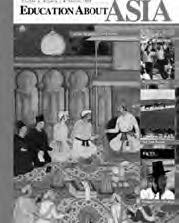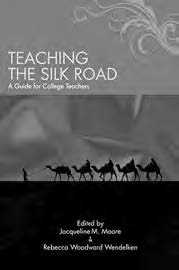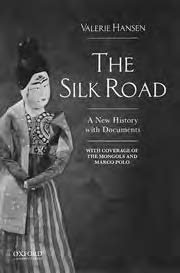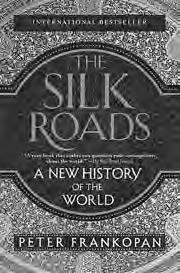The concept Silk Road(s) is prominent in Asian studies for a variety of reasons. It first became influential in the second century BCE, has served multiple functions throughout world history, and remains important in the present and, most probably, well into the future. The essay that follows is intended for middle, high school, and undergraduate instructors, and includes a brief EAA article from over twenty years ago, a college teaching guide, and three different books. Instructors, and possibly students, who read this essay and sample the featured resources are assured of encountering diverse and provocative perspectives on teaching the Silk Roads.
 “The Silk Roads: An Educational Resource”
“The Silk Roads: An Educational Resource”
In the spring 1999 issue (vol. 4, no. 1), Education About Asia published a short, but excellent, article by the eminent scholar Professor Morris Rossabi entitled “The Silk Roads: An Educational Resource.” This article should be reviewed for Rossabi’s discussion of themes to be taught, individual travelers on the Silk Roads, and his suggestions for source materials at that time. Rossabi’s comments on teaching about a Han Dynasty princess, a diplomat, a Buddhist monk, Marco Polo, a late
nineteenth century explorer, and a modern-day Uyghur nationalist open the door to creative teaching.
 Teaching the Silk Road
Teaching the Silk Road
A Guide for College Teachers
Edited by Jacqueline M. Moore and
Rebecca Woodward Wendelken
Albany: State University of New York Press, 2010
256 Pages, ISBN: 978-1438431024,
Paperback
Teaching The Silk Road: A Guide for College Teachers was published in 2010, and at a length of 238 pages contains many insightful suggestions ranging from K-12 to higher education. Teachers of World History, European History, Chinese History, Political Science, Comparative Politics and Art History will find chapters for each discipline. Chapters on Nomads and National Identity are creative. Discussions of Service Learning, Experiential Learning, and Study Abroad are thought-provoking in a time when taking students to Asia remains problematic for now. Activities such as map making and using primary sources are also included. The book concludes with a moving personal reminiscence of growing
up in Khotan, which is in the Xinjiang Uyghur Autonomous Region of China. Teaching the Silk Road is a valuable resource, and I hope it will be updated as so much has changed since 2010.
 The Silk Road
The Silk Road
A New History With Documents
By Valerie Hansen
New York: Oxford University Press, 2016
496 Pages, ISBN: 978-0190208929,
Paperback
Valerie Hansen’s The Silk Road: A New History With Documents is an updated edition of her prize-winning book published in 2012. Hansen is a history professor at Yale University. The thesis of the book is that the Silk Road “became one of the most transformative super highways in human history—one that transmitted ideas, technologies and artistic motifs, not simply trade goods.” (5)
Readers must be prepared for two intriguing caveats to the thesis. Hansen argues that silk was not the most important commodity—paper from China was more important because paper was used in printing. Also, there never was an actual road, but rather “unmarked paths” followed by travelers and caravans. After the caveats, she described a “new history.”
Ideas included cultural exchanges, legal systems, travel passes, contracts, religious concepts, inheritance laws, loan arrangements, marriage practices, paper money, polygamy, prenuptial arrangements, reincarnation, sales practices, slavery, and taxation. Ideas were transmitted via many languages such as Kuchean, Chinese, Sanskrit, Gandhari, Agnean, and Sogdian. Religious
concepts from Zoroastrianism, Manichaeism, Buddhism, Islam, Judaism, and Christianity were thoroughly discussed to illustrate the of ideas over long distances.
Hansen emphasized the transfer of technology from China to the West with the making of paper and silk. One of her caveats is that paper was more important than silk. Technology transfer was linked to wandering refugees. She found that by 750 CE knowledge of how to make paper and silk moved out of China towards Europe.
Artistic motifs seen in paintings were discussed throughout the book as important clues of transmitted concepts. Hansen even found motifs from the Roman Empire in the Kingdom of Kroraina, which stretched for some 350 miles along the southeast border of the Taklamakan Desert. Moving into art history, Hansen identified Dunhuang as a place which must be visited on the Silk Road because of significant Buddhist paintings showing motifs from Central Asia, China, Iran and India. Furthermore, she discussed Buddhist, Manichean, Zoroastrian, Judaic, and Christian texts found in caves at Dunhuang.
This book is organized as chapters focusing on sites from Samarkand to China during the time period of 200 CE to 1400 CE. Excellent maps are provided to locate featured sites. The sites are Kroraina, Kucha, Turfan, Samarkand, Chang’an, Dunhuang, Khotan, Xinjiang, and Beijing. The last chapter was added to include the Mongols and Marco Polo.
Much of this book is based upon documentary sources and recent archaeological research. The details of trade and travel were emphasized and led the author to thought-provoking and challenging conclusions. For example, she argues that the volume of trade was surprisingly small and China traded more with Samarkand than Rome. We should remember Sogdians, from Persia, as the “great travelers of the past…”
Thus, Hansen moves attention away from Rome and silk to paper and sites between Central Asia and China up to the fourteenth century. It is easy to see why the research in this book won a prize in 2013 from the International Convention of Asian Scholars. The emphasis on ideas, technologies and arts motifs makes for a very instructive book with a geographic focus and a defined time period. The Silk Road: A New History with Documents challenges us to think about what to teach on one of the central topics in Asian studies.
 The Silk Roads
The Silk Roads
A New History Of The World
By Peter Frankopan
New York: Alfred A. Knopf, 2016
643 Pages, ISBN: 978-1101946329,
Hardcover
Peter Frankopan’s The Silk Roads: A New History Of The World was published in 2016. Frankopan is a scholar at Oxford University. His thesis is that the Silk Roads carried world history from the “cradle of civilization,” which is in Central Asia, not the Mediterranean region. This is, of course, explicitly in opposition to Western ideas about the origins of civilization. Frankopan describes world history as moving with the East rising over the West. He wants to prompt new questions to challenge traditional truisms and explains that Asia is “the centre of the world.” (XIX)
Frankopan’s study is characterized by large generalizations and an extremely wide inclusion of events and concepts in his understanding of the Silk Roads. His thesis was presented as a macrohistory of topics. Hansen’s book is characterized by archaeological research on specific sites.
In the beginning of his book, Frankopan, as opposed to Hansen, emphasized that silk was the most important commodity traded on the Silk Roads. He paid little attention to Chinese paper and described silk as an international currency. In fact, so much silk reached Rome that it upset Roman society to the point that there were laws banning silk. At one time the expenditure on silk equated to half of the coinage minted in Rome. Thus, from the beginning Frankopan’s history is very different from Hansen’s, even though he cited her book.
After commenting on ancient Rome, Frankopan proceeded to explain his wide-ranging understanding of the Silk Roads. His next topic began in Chapter 2, “The Road of Faiths,” where he discussed the ideas of Zoroastrianism, Judaism, Christianity, Buddhism, and Islam. The eastward movement of Christianity and Islam along the Silk Roads was given much attention along with the westward and northward movements of Buddhism. Frankopan believes that Eastern Christianity has been somewhat forgotten in history. The eastward movement of Islam enters the story after the seventh century carried the narrative into China.
Frankopan’s topics also include Russian history at various times along the Silk Roads. He linked the Rus’, or Russians, with two trade commodities—furs and slaves. As Muslim merchants traveled east, they began to carry furs from lands that came to be known as Russia. According to Frankopan, there was a large slave trade involving the Rus’ and many other peoples. This brought the Rus’ south to Constantinople and more connections with the Silk Roads.
As he moved forward in time past the eleventh century, Frankopan returned again to a religious theme—the clash of Islam and Christian Crusaders that involved Constantinople—a major western terminus of the Silk Roads. Frankopan’s wide view includes the Crusaders in search of a road to heaven.
The Mongols are the next topic covered by Frankopan, and he used them to portray world history moving from the East to the West. Frankopan described the huge loss of life because of the Mongol conquests, but also stressed that organization, strategy, tactics, religious tolerance and economic advancement must be recognized in understanding the Mongols. The Black Death was identified as the “most important effect” of the Mongols in history because Europe was almost destroyed by disease but made a spectacular recovery to lead history back to the East in the sixteenth century. (182)
Frankopan segued toward modern times by narrating how the West moved toward the East in the era from 1492 to 1920—from the voyages of Christopher Columbus to World War I. The era began with Europeans going east to find spices, silk and porcelain and then bringing silver to China. Moving ahead in time, the contest of the British and Russians racing to Central Asia in the nineteenth century is featured—this is the story of the Silk Road carrying history.
Readers must brace themselves for what follows! Frankopan brought in many topics including World War I; petroleum; the USSR; World War I; wheat; World War II; the Cold War; America in Iraq, Iran and Afghanistan; Superpower competition; Russia and Ukraine, and finally, Xi Jinping’s New Silk Road in the twenty-first century. Frankopan found ways to tell us that modern history moved along the Silk Roads to the East.
In Frankopan’s view Silk Road history involves World War I, petroleum, the USSR and England in a contest to control geography from Egypt to India—once again a precious resource was pulling the world eastward. The “Great Game” for control of Afghanistan was portrayed as a prelude to World War I. The author makes the interesting assertion that Russia had Silk Roads in the form of railroads built eastward towards China. The June 28, 1914 assassination that led to World War I was described as a Silk Roads event which changed the world. By the time World War I ended in 1918 Western nations, especially England, recognized that Middle Eastern petroleum was a resource that must be procured for use by modern navies.
Furthermore, the author contends that the 1917 Russian Revolution was a showdown between East and West. Frankopan was describing the expansion of the USSR to the east by creating Central Asian republics while Britain sent troops into Afghanistan with India always as a concern. Thus, in the 1920’s the British were involved in nations from the Middle East to India while the USSR stretched east with Soviet Republics to the north of the British controlled region. By the 1930’s Iran had the world’s largest oil refinery—petroleum was the new treasure on the Silk Roads as history went to the East.
Frankopan presents the momentous events of World War II and the beginning of the Cold War within his wide-ranging concept of Silk Roads. Much attention was placed on Hitler’s strategy to go east into the Soviet Union to secure food, especially wheat from Ukraine, in pursuit of future security for the Third Reich. In addition to this strategy, Frankopan stressed that Hitler also saw a way to go from the Middle East through Iran to Central Asia to India. Thus, Hitler had two Silk Roads in World War II.
Placing America on the Silk Roads is a startling example of Frankopan’s understanding of his topic. The decades from 1950 to 2010 are described as a time when American national security was tied to the region from the Middle East to Central Asia. Thus, America’s Silk Road was a line of countries including Egypt, Israel, Iran, Iraq, Afghanistan, Pakistan, and India. Notice that these countries are along the southern flank of the USSR/Russia and became a major factor in the Superpower Rivalry. Frankopan reviewed how America was pulled eastward by the Iranian Revolution of 1979, the Gulf War of 1991, the attacks on America on September 11 , 2001 followed by the occupation of Afghanistan and the Iraq War of 2003-2011. America’s Silk Road was a road of war.
Xi Jinping announced a New Silk Road in 2013—Frankopan linked Xi’s New Silk Road to great changes in global history. The words “global” and “the Silk Roads are rising again” are the keys to his last chapter. (504) Events after 1990 were described as a disaster for the West as chaos erupted from Turkey eastward involving Russia, Ukraine, and Xinjiang in China. The need to control natural resources such as oil, natural gas, grains and precious minerals was identified as the reason for much turmoil. As Frankopan saw this, he wrote, “The age of the west is at a crossroads, if not an end.” (503) Thus, Xi Jinping came forward with his New Silk Road and goals of economic development, communications and trade. Frankopan ended his book by reiterating that the Silk Roads are rising again.

Conclusion
Morris Rossabi’s short article from 1999 is a good place to start in staying current on the Silk Road(s)—he identified themes to be taught and important resources. Jacqueline M. Moore and Rebecca Woodward Wendelken edited a teacher’s guide, published in 2010, which should be updated because the structure is logical and covers K-12 and higher education teaching.
Valerie Hansen’s and Peter Frankopan’s world histories are different in geography, time spans, and scope. Hansen wrote about specific sites, spread
over some 2,000 miles, while Frankopan’s scope is broader. Hansen’s book ends in 1400 CE, while Frankopan’s ends in 2013. Frankopan discusses the
histories of nations, empires, and events that Hansen does not include in her book. This is not criticism, just description. Both books are excellent world history contributions. What book(s) would you use? Hopefully, readers more clearly understand different but legitimate perspectives on the Silk Road(s).

